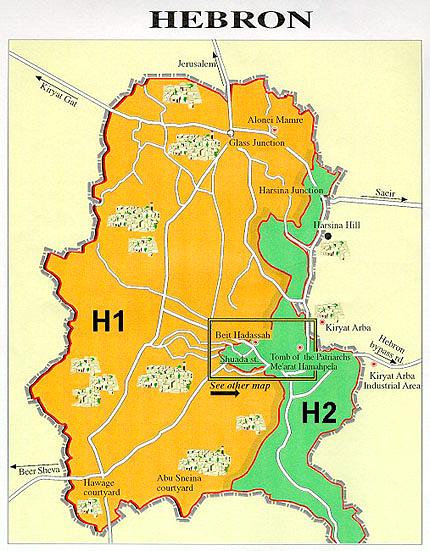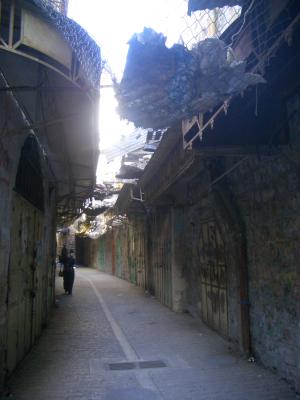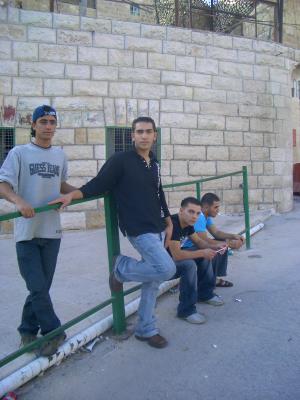One day in Hebron
 Because the border into the Gaza Strip has been closed, I've decided to check out the city of Hebron. Hebron is a major Palestinian population centre in the south of the West Bank. It also happens to be one of the more volatile places in the region because it is intersected by three Jewish settlements, one of which literally juts immediately into the centre of Hebron's old city (the area marked with a box in the map below. The green area marks the settlements). Hebron has 140,000 indigenous Palestinians and 400 settlers, all recent migrants, 'protected' by several hundred Israeli soldiers.
Because the border into the Gaza Strip has been closed, I've decided to check out the city of Hebron. Hebron is a major Palestinian population centre in the south of the West Bank. It also happens to be one of the more volatile places in the region because it is intersected by three Jewish settlements, one of which literally juts immediately into the centre of Hebron's old city (the area marked with a box in the map below. The green area marks the settlements). Hebron has 140,000 indigenous Palestinians and 400 settlers, all recent migrants, 'protected' by several hundred Israeli soldiers. Hebron to me felt like a microcosm of the Occupation and a glimpse into the future direction of Israel's illegal expansion into what's left of the Palestinians' land. Although I only spent a day in Hebron I toured the old city extensively. The old city is the heart of Hebron. It also happens to be at the centre of most of the violence. Here's some photos I hope captures something of what life in Hebron is like for the Palestinians.*
Hebron to me felt like a microcosm of the Occupation and a glimpse into the future direction of Israel's illegal expansion into what's left of the Palestinians' land. Although I only spent a day in Hebron I toured the old city extensively. The old city is the heart of Hebron. It also happens to be at the centre of most of the violence. Here's some photos I hope captures something of what life in Hebron is like for the Palestinians.*
 This charming couplet of 'wall art' is courtesy of Jewish settlers from Kiryat Arba. Kiryat Arba sits on top of an old Palestinian neighbourhood. My guess is this rubbish was spray painted by some settler kids. The Israeli police can't detain kids younger than 12. As a consequence, settler kids 12 and younger are considered the greatest menace by Israeli police and the local Palestinian population alike. They routinely pelt Israeli police car with stones. I was told that one policeman deliberately did not move his car when settler kids started throwing stones at it in the hope that one of the windows would break and he could fine their parents.
This charming couplet of 'wall art' is courtesy of Jewish settlers from Kiryat Arba. Kiryat Arba sits on top of an old Palestinian neighbourhood. My guess is this rubbish was spray painted by some settler kids. The Israeli police can't detain kids younger than 12. As a consequence, settler kids 12 and younger are considered the greatest menace by Israeli police and the local Palestinian population alike. They routinely pelt Israeli police car with stones. I was told that one policeman deliberately did not move his car when settler kids started throwing stones at it in the hope that one of the windows would break and he could fine their parents. Here you can see some narrow walkways in Hebron's old city. Note that all the shops are shut. This is a direct consequence of settler attacks on the locals. If you look closely you will see rubbish bulging down from nets covering the roof tops. The rubbish is thrown down by settlers who occupy the dwellings above the old city. Like the racist graffiti pictured above, you don't need to go out of your way to find images like this. It tends to be the other way around. The images abruptly confront you.
Here you can see some narrow walkways in Hebron's old city. Note that all the shops are shut. This is a direct consequence of settler attacks on the locals. If you look closely you will see rubbish bulging down from nets covering the roof tops. The rubbish is thrown down by settlers who occupy the dwellings above the old city. Like the racist graffiti pictured above, you don't need to go out of your way to find images like this. It tends to be the other way around. The images abruptly confront you. A Palestinian man smokes despondently as Israeli soldiers seize his bedroom. The door to this room is to the left of him. An international monitor who was also in the house told me that the Israeli soldiers probably wanted somewhere to sleep for the night and were too afraid to sleep at the checkpoints which are in the heart of the old city and therefore vulnerable to militant attacks. It's worth noting that the soldiers are also probably using the family as a form of human shield. Otherwise why not sleep in one of the unoccupied houses of which there are plenty?
A Palestinian man smokes despondently as Israeli soldiers seize his bedroom. The door to this room is to the left of him. An international monitor who was also in the house told me that the Israeli soldiers probably wanted somewhere to sleep for the night and were too afraid to sleep at the checkpoints which are in the heart of the old city and therefore vulnerable to militant attacks. It's worth noting that the soldiers are also probably using the family as a form of human shield. Otherwise why not sleep in one of the unoccupied houses of which there are plenty? Mr Mousa points to one of the bullet holes left when Baruch Goldstein, an ultra-orthodox Jew from the Kiryat Gat settlement, opened fire in the Tomb of Abraham mosque in 1994, killing 29 people and wounding several more. Settlers built a monument to Goldstein which I was unable to visit. Many settlers consider Goldstein a folk hero, not unlike the genocidal Custer of American folk lore, or many of the early 'pioneers' of Australia's outback.
Mr Mousa points to one of the bullet holes left when Baruch Goldstein, an ultra-orthodox Jew from the Kiryat Gat settlement, opened fire in the Tomb of Abraham mosque in 1994, killing 29 people and wounding several more. Settlers built a monument to Goldstein which I was unable to visit. Many settlers consider Goldstein a folk hero, not unlike the genocidal Custer of American folk lore, or many of the early 'pioneers' of Australia's outback. Now the Tomb of Abraham (pictured below) has separate access points for Muslims and Jews. A tragically childish way for the two communities to worship at the same place. The Muslim section is controlled by four Israeli checkpoints all manned by those ubiquitous young soldiers.
Now the Tomb of Abraham (pictured below) has separate access points for Muslims and Jews. A tragically childish way for the two communities to worship at the same place. The Muslim section is controlled by four Israeli checkpoints all manned by those ubiquitous young soldiers. I spoke to these four teenagers just before entering the Tomb of Abraham. By the time I came back, around 15 minutes later, they told me the Israeli soldiers at the checkpoint (which is around the corner from where this photo was taken) had detained them and taken their IDs. They said this happens to them close to every day.
I spoke to these four teenagers just before entering the Tomb of Abraham. By the time I came back, around 15 minutes later, they told me the Israeli soldiers at the checkpoint (which is around the corner from where this photo was taken) had detained them and taken their IDs. They said this happens to them close to every day. The Israelis routinely close off walkways within the old city, ostensibly on the grounds of security. The people who live behind this particular barrier have to walk an extra ten minutes to reach the point from which I took the above photo, which also happens to be one of the main thoroughfares through the old city. Another example of how Israel makes daily life for the Palestinians difficult. Torture by a thousand cuts.
The Israelis routinely close off walkways within the old city, ostensibly on the grounds of security. The people who live behind this particular barrier have to walk an extra ten minutes to reach the point from which I took the above photo, which also happens to be one of the main thoroughfares through the old city. Another example of how Israel makes daily life for the Palestinians difficult. Torture by a thousand cuts.Epilogue
That night I slept in a small hostel literally on the border between the (Palestinian) old city and the Kiryat Gat settlement. I didn't sleep too well. Here's why - an Israeli armoured vehicle swept noisely through the old city's narrow streets at least three times (probably more, given that I may have slept through some of the other visits). Sporadic machine gun fire could be heard what I estimate to be around half a kilometre away throughout the night, ending around 4am. How can people live like this?
* For a more detailed summary of social and political situation in Hebron click here.



0 Comments:
Post a Comment
<< Home